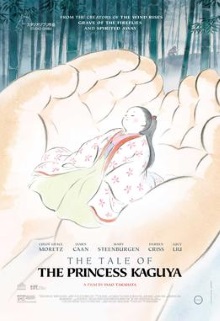
It seems strange, but animated features have a much higher hit-to-miss ratio on this blog so far than live-action films. The Tale of the Princess Kaguya, Studio Ghibli’s longest feature to date with a running time of 137 minutes, not only reinforces this trend, it knocks it out of the park by easily being one of the best films I’ve seen over the course of the year.
Directed and co-written by Ghibli veteran Isao Takahata, this film is based on the traditional Japanese folk tale The Tale of the Bamboo Cutter. In it, a childless peasant couple happen upon a miniature girl inside a glowing bamboo shoot. Seeing her as a divine blessing, they adopt her and find that she grows up miraculously fast. After also finding gold and fine silks amidst the bamboo, the humble bamboo cutter decides that this must mean that heaven intends for her to be a real princess and relocates his household to the capital where the child can be educated and raised as a proper noble.
It’s a simple tale with many parallels reflected in similar stories from all around the world yet there is enough going on and enough modern additions to the original story so that it continues to surprise and delight throughout. For example, the story involving the childhood friend Sutemaru seems to be new as is the reason for Kaguya being forced to leave the Earth. Reading up on the story as it is traditionally told, I found this film’s version to be far superior. The character of Sutemaru is used to further illustrate how Kaguya could well have found happiness under different circumstances. Under lesser hands, it could easily have become just another story of forlorn love, but the film surprised me by its deft handling of the drama that felt both honest and true to the spirit of the original folk tale.
What makes this really stand out is its distinctive art style which resembles calligraphy. It had me won over early on with a wonderful sequence of the baby Kaguya happily crawling and tumbling all over the floor with each frame being rendered with what looks like only a handful of brush strokes. The minimalist design is a perfect match for the elegant simplicity of its story, resulting in a film that has all of the refined beauty of a haiku. Yet the art style is also able to expand and adapt to fit the needs of the moment. In one powerful scene in which Kaguya descends fully into fear and rage, the entire screen is nothing but a mass of thick, angry black lines. Another fantastical flight scene shows how the art style can accommodate all of the grandeur of the countryside seen from above.
As my wife notes, its one misstep is its closing shot which is not only an anime cliché but feels dishonest in the context of the story. It is an insignificant flaw however in what is otherwise a perfectly crafted film. This is a work that at different times conveys joy, humor, wistfulness, sadness, an entire range of emotions and does it without being preachy or sentimental. It is also one of the most beautiful examples of animation that I can think of. There are not many films I think that can be admired both by cinephiles well versed in the best that the medium can offer and the less discerning general public. To my mind, The Tale of the Princess Kaguya is one of these rare films.